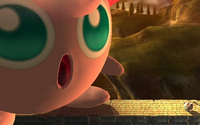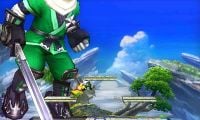Glitch: Difference between revisions
(General cleanup - corrected some "bad" English, rephrased the odd sentence. If it seems like a rewrite, sorry, it wasn't meant to be, I just got carried away. Feel free to revert it if you want.) |
Tag: Mobile edit |
||
| (84 intermediate revisions by 44 users not shown) | |||
| Line 1: | Line 1: | ||
{{ArticleIcons|series=y}} | |||
A '''glitch''' is an | {{disambig2|oversights in programming|the national tournament|Tournament:Glitch}} | ||
:''For a list of all articles related to glitches, see [[:Category:Glitches|Category:Glitches]].'' | |||
A '''glitch''' is an oversight in programming of a video game and how it may act in some circumstances. They alter [[gameplay]] by causing events or actions to occur that were not intended by the game's designers. | |||
==Overview== | |||
[[File:Jigglypuff glitch.png|200px|thumb|The [[Regenerating terrain glitch]] in ''[[Brawl]]'' that makes {{SSBB|Jigglypuff}} very large after using its Final Smash when the bridge is reforming.]] | |||
The main reason for a glitch existing is that the player creates a specific situation where the game does not know exactly what to do, resulting in unusual behavior. Glitches were either never encountered during a game's testing, or were simply not addressed before a game officially released. The larger and more complex a game is, the more likely glitches are to exist, simply due to the increased difficulty in testing every possible situation and finding what part of the source code is causing the problem. Glitches are not to be confused with [[exploit]]s, which involve multiple gameplay elements working as intended, yet yielding unintended results. Glitches are the game specifically not working as intended. | |||
By definition, glitches can cause basically anything to happen. The effects that glitches cause can vary. Glitches can be harmful, with such side effects as freezing the game, causing a level to be unplayable, or ruining the experience of others if a game has multiplayer. Not all glitches, however, have negative side effects; some are ultimately harmless and sometimes humorous, like altering character models or forcing prompts to trigger at weird times, while others can even allow players to access content they were never supposed to, like a [[Debug menu]] or swapping to non-playable characters. Depending on the game, some glitches are considered a net positive, such as glitches that expand gameplay options and act as roundabout quality of life improvements. Content that mostly works as intended but have strange characteristics are usually called “jank” (i.e. Mario’s dash attack in ''Smash 4'' stage spikes opponents on the ledge, or Pokémon Stadium’s odd collision detection during the Fire transformation). | |||
==In the ''Super Smash Bros.'' series== | |||
[[File:SSB4 Giant Yoshi Glitch (Multiplayer).jpg|thumb|The [[Egg Lay]] glitch in {{for3ds}} that was patched out in version 1.0.4.]] | |||
A fair number of glitches have been discovered in every ''Smash'' entry. While those found in ''SSB'', ''Melee'', and ''Brawl'' can be found to this day due to developers not being able to alter code on printed physical media after release at the time, some can only be found in specific versions due to it being patched out of later reprints. ''Smash 4'' and ''Ultimate'' have the privilege of receiving update patches after release, allowing glitches to be dealt with in a timely matter at relatively little cost. | |||
[[de: | Through a competitive lens, glitches are complicated to deal with, as some are considered worse than others. Easily repeatable glitches that negatively disrupt gameplay, like game crashes or the [[Freeze glitch]] in ''Melee'', as well as glitches that lead to [[broken]] techniques like the [[Infinite Dimensional Cape]] are usually banned and the guilty parties are punished accordingly. However, some glitches are deemed positive to the overall health of the game, such as the {{SSB|Teleport}} in ''Smash 64'' and [[Yoyo glitch]] in ''Melee''. These are usually allowed with no restrictions as they are perceived to add to the afflicted characters' [[metagame]]s. Some glitches tangibly affect the game, but not in ways that are considered obtrusive, such as the [[stock glitch]] in ''Melee''. These typically have no official ruling and are de facto legal as there is no reason for specifications in the rules. | ||
The subsect of the ''Smash'' [[community]] that partakes in [[speedrun]]ing takes a different approach to handling glitches. Typically, the any% category allows any and all glitches while the glitchless category does not allow any. That being said, a glitch is sometimes discovered that cuts down so much time that it completely invalidates all runs that came before. In order to prevent said previous runs from falling into obscurity, a branch of the any% category is often created that disallows this newfound glitch and potentially others. That way, the main any% category can continue to innovate while those that want to continue the "traditional" way still have the option to develop an insular community. There are some extreme examples, such as the [[pause glitch]] in the original ''Super Smash Bros.'', that are discouraged from use, and runs that utilize them are often not recognized on leaderboards when submitted. | |||
==See also== | |||
[[List of glitches (SSBM)]] | |||
<!-- List of glitches (SSB) | |||
List of glitches (SSBB) | |||
List of glitches (SSB4) | |||
List of glitches (SSBU) --> | |||
[[Category:Game mechanics]] | |||
[[Category:Glitches]] | [[Category:Glitches]] | ||
[[Category:Glitches (SSB)| ]] | |||
[[Category:Glitches (SSBM)| ]] | |||
[[Category:Glitches (SSBB)| ]] | |||
[[Category:Glitches (SSB4)| ]] | |||
[[Category:Glitches (SSBU) | ]] | |||
Latest revision as of 08:25, April 18, 2024
A glitch is an oversight in programming of a video game and how it may act in some circumstances. They alter gameplay by causing events or actions to occur that were not intended by the game's designers.
Overview[edit]

The main reason for a glitch existing is that the player creates a specific situation where the game does not know exactly what to do, resulting in unusual behavior. Glitches were either never encountered during a game's testing, or were simply not addressed before a game officially released. The larger and more complex a game is, the more likely glitches are to exist, simply due to the increased difficulty in testing every possible situation and finding what part of the source code is causing the problem. Glitches are not to be confused with exploits, which involve multiple gameplay elements working as intended, yet yielding unintended results. Glitches are the game specifically not working as intended.
By definition, glitches can cause basically anything to happen. The effects that glitches cause can vary. Glitches can be harmful, with such side effects as freezing the game, causing a level to be unplayable, or ruining the experience of others if a game has multiplayer. Not all glitches, however, have negative side effects; some are ultimately harmless and sometimes humorous, like altering character models or forcing prompts to trigger at weird times, while others can even allow players to access content they were never supposed to, like a Debug menu or swapping to non-playable characters. Depending on the game, some glitches are considered a net positive, such as glitches that expand gameplay options and act as roundabout quality of life improvements. Content that mostly works as intended but have strange characteristics are usually called “jank” (i.e. Mario’s dash attack in Smash 4 stage spikes opponents on the ledge, or Pokémon Stadium’s odd collision detection during the Fire transformation).
In the Super Smash Bros. series[edit]
A fair number of glitches have been discovered in every Smash entry. While those found in SSB, Melee, and Brawl can be found to this day due to developers not being able to alter code on printed physical media after release at the time, some can only be found in specific versions due to it being patched out of later reprints. Smash 4 and Ultimate have the privilege of receiving update patches after release, allowing glitches to be dealt with in a timely matter at relatively little cost.
Through a competitive lens, glitches are complicated to deal with, as some are considered worse than others. Easily repeatable glitches that negatively disrupt gameplay, like game crashes or the Freeze glitch in Melee, as well as glitches that lead to broken techniques like the Infinite Dimensional Cape are usually banned and the guilty parties are punished accordingly. However, some glitches are deemed positive to the overall health of the game, such as the Teleport in Smash 64 and Yoyo glitch in Melee. These are usually allowed with no restrictions as they are perceived to add to the afflicted characters' metagames. Some glitches tangibly affect the game, but not in ways that are considered obtrusive, such as the stock glitch in Melee. These typically have no official ruling and are de facto legal as there is no reason for specifications in the rules.
The subsect of the Smash community that partakes in speedruning takes a different approach to handling glitches. Typically, the any% category allows any and all glitches while the glitchless category does not allow any. That being said, a glitch is sometimes discovered that cuts down so much time that it completely invalidates all runs that came before. In order to prevent said previous runs from falling into obscurity, a branch of the any% category is often created that disallows this newfound glitch and potentially others. That way, the main any% category can continue to innovate while those that want to continue the "traditional" way still have the option to develop an insular community. There are some extreme examples, such as the pause glitch in the original Super Smash Bros., that are discouraged from use, and runs that utilize them are often not recognized on leaderboards when submitted.
